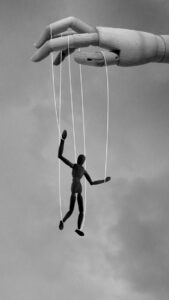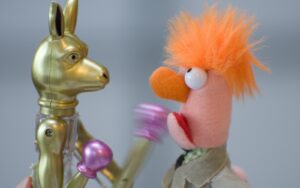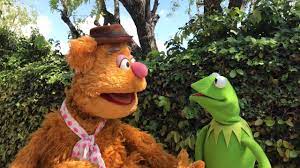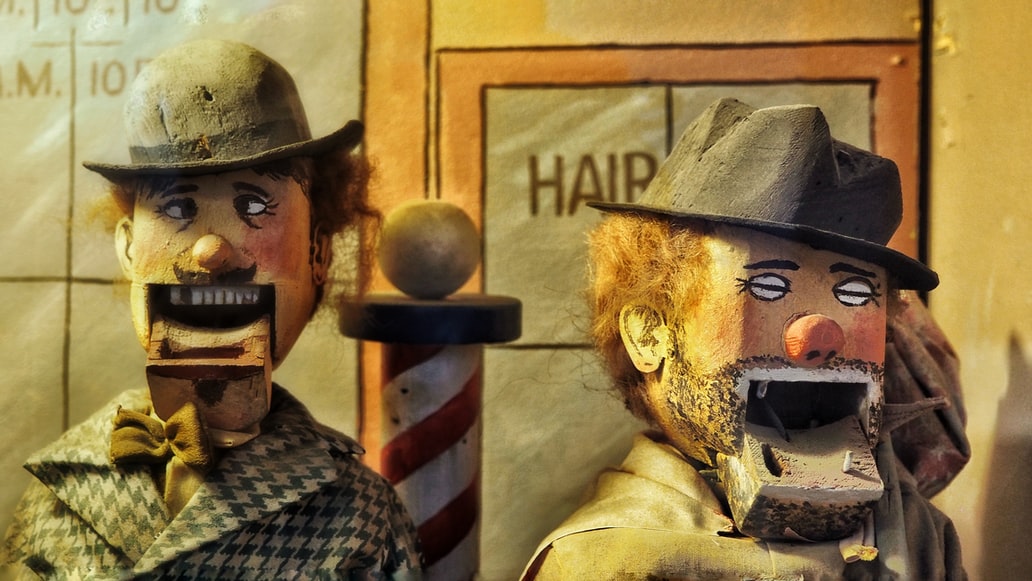PUPPETS AND IMPROVISATION

Like Masks, Puppets have an other-world quality. Some of us love them while others are freaked out by their “creepiness”. Love them or hate them puppets bring technical skills, creative skills and even some deep metaphoric insights that will make us better improvisers.
WHY PUPPETS?
Why should we stick our hands up the butt of a puppet and give it a voice when we can move and speak for ourselves?
 Consider the ongoing presence puppets have had for the past 4000 years in human cultures (historical records from Greece and Egypt.) Puppets endure because they offer something beyond what the “fleshies” can.
Consider the ongoing presence puppets have had for the past 4000 years in human cultures (historical records from Greece and Egypt.) Puppets endure because they offer something beyond what the “fleshies” can.
And let’s step into the mid-1930’s where LAURETTA BENDER M.D., and ADOLF G. WOLTMANN, had made groundbreaking claims that puppets were accomplishing things in therapy for children suffering from trauma that therapists could not. This early observation of puppetry opened an interesting door to spontaneous interaction with these “toys” on a whole other level.
The puppet may look like a human representative but it’s not human of course. That distance allows us hidden access to our inner world.
A scene with a single blue puppet in a room of red puppets for example gives us an easy way to play a scene about racism in a show where the performers may not have the finesse to deal with the topic on a more direct level.
Royalty in the European courts could not be offended with the criticism of the foolish, ranting stick figures dancing on their tiny stages. But hidden in those tiny disarming creatures is all the opinions of those performers now empowered by the protection of the puppet.
Why Puppets? They are another tool in the improviser’s arsenal to create connection, spontaneity, communication and truth. They help us reach the audience and can help us to reach a truer version of ourselves.
HOW PUPPETS?

Anyone can pick up marionettes, hand puppets, Bunraku, shadow puppets, etc, but if you want to unleash the power of a puppet you need to learn, explore and play.
Improvisers are typically a lazy bunch (yes you are – most of you) and it’s easy enough to just pick up a puppet and make a voice, but to bring the most out of the creature in your hand, explore some technique.
Practically, dancers learn technique from specific styles so they can express themselves with a wider range. Actors do the same. Artists and Writers without technique can paint and tell stories but with practice, they can create a masterpiece. Imagine what you can do with a little technical insight on fixed point, rhythm of movement and an understanding of a variety of puppet styles?
Here’s some influences to inspire you:
- Basic Bunraku – If you haven’t seen Bunraku inspired puppetry, search YouTube for more. It’s a beautiful example of collaborative character creation.
- Found Material Puppets – Some people avoid puppet exploration because they don’t have a puppet. Improvisers know puppets are everywhere. You can use your naked hand (check out this exercise) and you can use newsprint or plastic bags. You give the character life. The audience helps with their imagination if your commitment and technique is strong. Check out the plastic bag puppets.
- Marionette – Watch Rick Syers bring his character, STIX to life for seniors. Elegant and subtle movement creates strong emotions. Like acting, “less is more. Each puppet is different. Exploration and play help you discover the character and relationship.
- Hands and Hand Puppets – This is really basic but consider these three qualities to practice: Focus, Lip sync and Character. It’s not everything but it’s a good place to start.
- Rod and Shadow Puppets – Master Puppeteer Hobey Ford is an inspiration. Check him out here.
- Check out these great tips and insights from a bunch of Muppeteers on Sesame Street. “You take a piece of your personality and BLOW IT UP. That becomes the essence of the character.” -Matt Vogel (Big Bird)
You have a GREAT advantage with your impro training. Your ability to risk, play, explore, create characters, give into spontaneous impulses, etc etc etc are massive skills in the puppet world.
IMPROVISERS IN A PUPPET WORKSHOP
In a five day workshop at Det Andre Teatret, Oslo Norway, I teamed up with Polish puppeteer, Dominika Minkacz-Sira. We were going to mix Improvisation and Puppetry after a short training/exploration period with 10 improvisers and puppeteers.
I was inspired to watch the improvisers take the Puppetry technique and bend the possibilities of expression with their Improvisation skills. It became evident that what they knew as improvisers enhanced their puppetry while their skills to improvise improved with the puppets.
One element that improvisers strive for is the ability to call out the obvious as it appears. Improvisers who struggled with this behaviour achieved it easily with puppets in hand.
One day we played with an old Keith Johnstone exercise called “What Comes Next”. Performers create stories and ask “what comes next?” during the improvised scene. The performers on the outside suggest the obvious thing to move the story forward.
We played the exercise with puppets and human performers. At many points in the afternoon, arguments would break out with performers and their puppets. In one instance a performer suggested that the character go into a store after he had been walking in a forest, listening to the birds. The puppet turned to the performer and asked incredulously, “Really?!?!” (The puppet was right. No one in the audience was thinking he should go into a store).
Remember, this is the same person arguing with himself. Puppet and performer
 An argument broke out and the puppet let loose a hilarious tirade of insults on the poor performer. The performer asked if the puppet had a better idea. HE DID! “Climb the tree and look into the nest of baby birds and contemplate your own inability to procreate!!! IDIOT!! “
An argument broke out and the puppet let loose a hilarious tirade of insults on the poor performer. The performer asked if the puppet had a better idea. HE DID! “Climb the tree and look into the nest of baby birds and contemplate your own inability to procreate!!! IDIOT!! “
The last part of the suggestion was a consequence of the fighting between puppet and puppeteer but even with that, there was a latent logic in what the Puppet was suggesting.
This was a common experience. The honesty and passion of the puppets were immediate. The Puppets were rarely subtle. They didn’t hide from spontaneous impulses.
I KNOW IT’S THE SAME PERSON at either end of the arm. But their behaviour was remarkably different. The addition of the puppet disarmed the pressure to be right. Any doubt in the performer’s mind became inspiration for the puppet to speak. The puppet could make the riskiest offers, and the improviser was off the hook.
The improviser was a normal human like the rest of us. The Puppet was the vulnerable, weird, offensive, one. We all preferred watching the puppet.
IMPRO PUPPET PERFORMANCE:
As variation in performances, puppets appear sporadically in shows all over the world. Once and a while you hear of a group exploring a stronger focus on the puppets, using them in all of their scenes.
Brian Henson, son of Jim Henson, was told that there was no way Puppet impro would work as a full show. He, and a select group of performers played, explored and eventually decided that the only way to know if it would work would be to do it in front of an audience.
Check out this clip where PUPPET UP – UNCENSORED plays a Keith Johnstone inspired game; Horn & Bell. Improvisers try to do a scene based on the true lives of audience members. The audience members pull them back when they get it wrong and reward them for getting it right.
Their show allows the audience to see the puppets as they might appear on a video screen but the audience can also watch the performers controlling the characters below. Here’s Brian Henson talking about the creation of Puppet Up -Uncensored
And take a look at KERMIT and FOZZZIE BEAR improvising together.  This is test footage for a movie but the words and interaction are unscripted. The playfulness, vulnerability and consistency of the characters at 9:05 in the clip are exactly what improvisers hope to achieve as improvisers on stage.
This is test footage for a movie but the words and interaction are unscripted. The playfulness, vulnerability and consistency of the characters at 9:05 in the clip are exactly what improvisers hope to achieve as improvisers on stage.
As a little bonus, check out Kermit the frog hosting the TONIGHT SHOW. At 46:54 in the clip, there is no denying that they are improvising. When it’s pointed out by Bernadette Peters that Kermit is naked. And the following section where Animal shows an obvious interest in the guest we can see the playfulness of everyone involved. No one here is trying to be funny. They are simply being consistent to the characters that they play. It’s a good lesson for all of us human improvisers.
GETTING REAL
The puppet is us but is also at arm’s length from ourselves like a very close friend, willing to tell us what they REALLY think. We give them permission to play with our latent fears and truths.
That’s a pretty powerful tool in our hands.
Practice and Play.
Experiment with Puppets in impro exercises and see what comes out of them for you. Explore the practical skills but most of all, explore and PLAY.




0 Comments